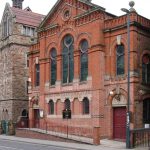Project undertaken using PSiCA funding
Nos. 49, 51, 53, 55 & 57 Wardwick
This parade of Grade II listed shops is at the centre of an attractive row of historic properties, located in Wardwick in the centre of Derby. Numbers 49-55 occupy a mid eighteenth-century building, which was converted to commercial use in the nineteenth century. Number 57, despite being of a later date (1890s), unlisted and in a completely different architectural style – was connected to its earlier neighbour through the surviving details of their historic shop fronts.
Through the PSiCA scheme, the unattractive, modern features of each property were removed. The surviving details of the late-Victorian/Edwardian era shop fronts were used to inform the design of the whole row. A continued mixture of commercial businesses continued to occupy the premises after the completion of the works.
Nos. 41, 43, 45 & 47 Wardwick
Located on Wardwick, this Grade II-listed building features three separate retail units and a separate access to the upper floors. The property was originally constructed as a dwelling, likely around the late-seventeenth/early-eighteenth century, before being adapted for retail use during the late-nineteenth century. Prior to the scheme, the units had a variety of problems which needed to be resolved, including the installation of inappropriate shop fronts and signage during the twentieth-century, advanced decay on a surviving historic door and its surrounds, and the deterioration of the upper floors of the property.
Through the PSiCA scheme, the original Victorian-era shop fronts were reinstated, based on historic evidence, as well as the historic door. The surviving shop surrounds, including pilasters and fascia, were repaired where possible, or reinstated to their original design. The issues within the upper floors were also resolved, including repairs to the render and a reconfiguration of the rainwater goods.
No. 26-27 Sadler Gate
Located on Sadler Gate, No. 26-27 is an unlisted late-Victorian property in close proximity to seven designated heritage assets. Prior to the grant, the property had been fitted with an modern shop front which was inappropriate for the building, and which negatively impacted upon the historic setting of Sadler Gate. A new frontage was reinstated, with the design reflecting the late-Victorian age of the property and the surrounding buildings. This previously vacant building was soon occupied by a new retailer.
Nos. 3, 4 & 5 The Strand Arcade
This small parade of shops is located within the Strand Arcade, which connects The Strand to Sadler Gate. The Arcade was constructed between 1874 and 1878 by Sir Abraham Woodiwiss, and designed by John S Story. It was the first arcade to be built in Derby. The arcade itself is not listed, however the entrance in the Strand is Grade II, as part of the wider street group.
The roof of the arcade had recently been repaired in 2006 during the Townscape Heritage Initiative, however a number of the retail units had been altered during modern times and suffered from years of neglect, resulting in missing stone pilasters and capitals. Using surviving historic details from nearby units as a reference and details which were uncovered beneath later alterations, new shop fronts and a lost pilaster were reinstated to return the units to their previous grandeur. Although the units had been vacant prior to the works, they were soon occupied by a mix of new retailers.
No. 29 Sadler Gate
No 29 Sadler Gate is situated at the western end of the street, close to the site of Sadler Gater Bridge. Though unlisted, the property appears to date to the late-eighteenth/early nineteenth century, and is surrounded by buildings of similar historic value. The shop front retained a number of historic details, with a number of twentieth century alterations and changes. This was also the case at first-floor level, where a large window which extended the width of the building, had been installed in the 1920s, replacing the earlier sashes.
Through the PSiCA, the traditional shop front was reinstated, based upon historic evidence. The historic shop surround was repaired, with any decayed timber spliced with new hardwood. At first floor level, the picture window was removed and three sash windows were reinstated, based upon the historic layout. The property was not vacant at the time of the work, but continued in the same use following its completion.
No. 40 Curzon Street
No. 40 Curzon Street is a public house, known as the Crown Inn. The building is unlisted and appears to date to the nineteenth century. The building was in dire need of repair, with the frontage cracking in the upper floors and missing in parts, including missing stone lintels. The roof of the property was also leaking. A number of stonework repairs and reinstatements were undertaken to rectify the issues, as well as repairs to ensure the water-tightness of the roof. The property has continued in use as a public house since the completion of the works.
No. 22 Iron Gate
This timber frame of this property in Iron Gate may date to the sixteenth century, though it features a number of additions from later centuries. The property is Grade II-listed, and at the time of the grant had had its original lead pipe stolen and was suffering from deterioration of its building fabric. A small grant was offered through the PSiCA to reinstate the lost lead pipe and to conduct urgent repairs to the visible cracks in the render, in order to halt any further deterioration of the structure.
The Royal Building, Victoria Street/Cornmarket
The Royal Building is a Grade II-listed landmark property, located at the corner of Cornmarket and Victoria Street. It was designed between 1837-9 by Robert Wallace, to be constructed after the culverting of Markeaton Brook, which previously flowed along the route of Victoria Street. The building was functioned as a hotel, known as the Royal Hotel, until 1951. It was also the meeting place of the Athenaeum Club, which occupied much of the Victoria Street elevation, and as a post office.
The building, required a multitude of repairs at the time of the grant, and had been subject to numerous inappropriate modern alterations. The repair schedule include works to the timber windows in the upper floors and the restoration of the building fabric, including stonework. The works also included the reinstatement of some of the 1930s-style timber shop fronts to replace the inappropriate modern frontages that had been installed in their place. The property was vacant prior to the works being undertaken, but is now occupied by a national restaurant chain at first floor level. A number of additional shop front reinstatements have been undertaken along the Victoria Street elevation as part of the Townscape Heritage scheme.
No. 1-7 St. James Street
The upper floors of this incredible, unlisted building had been neglected for decades. The roof had leaked extensively, causing damage to the building fabric, and many windows were deteriorating significantly. The causes of the damage were identified and the necessary repairs were undertaken to remedy any problems which were uncovered. This included repairs to many of the windows, with rotten timber being spliced with new hardwood.
Trinity Baptist Church, Green Lane
Located at the top of Green Lane, the Trinity Baptist Church is an unlisted chapel, dating to 1879. It was designed by Lawrence Bright of Nottingham in the Romanesque style and is constructed in brick, with some stone and polychrome brickwork detailing. Prior to the grant, the property showed signs of deterioration and damage in the building fabric. The main window was in a poor state of repair, the masonry needed repointing and the access door was also deteriorating.
The damage to the primary window was repaired and the entire elevation was repointed. The damage which had occurred to the entrance doors was also addressed. The church continues to function as a religious building, following the completion of the works.

